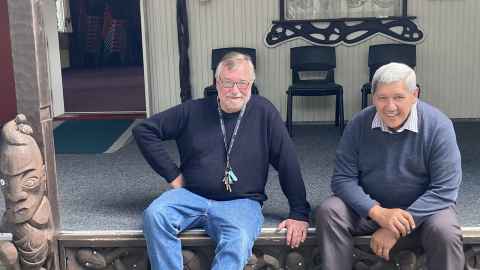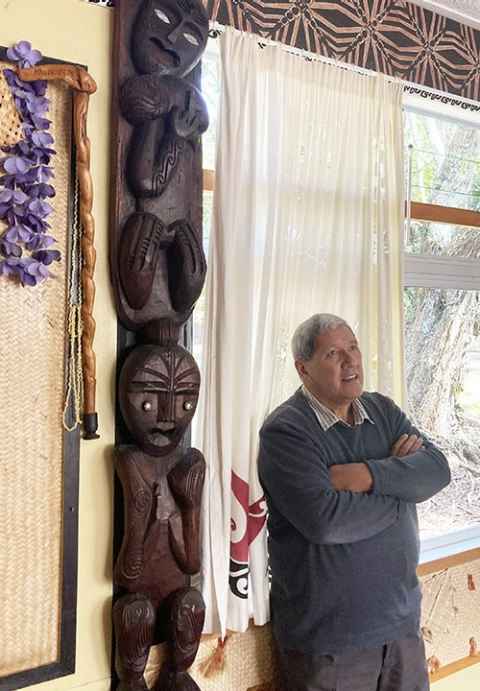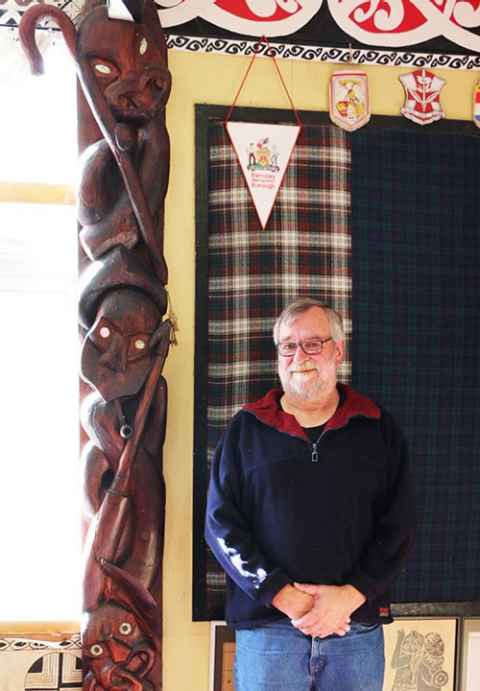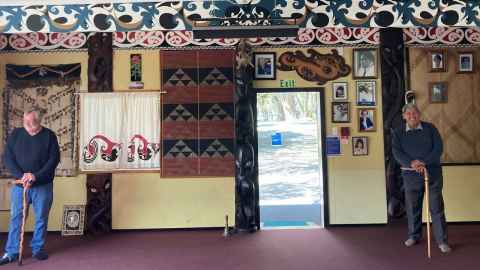Two men, two pou: a story from the marae at Epsom Campus
22 November 2022
Faculty-supported research into the Epsom Campus marae is unearthing stories of its rich history. Enduring relationships were forged, taonga crafted and a legacy built. One such story highlights two carved pou in the wharenui, write project co-ordinators Rose Yukich and Hēmi Dale.

At a moment in time 40 years ago in the grounds of Epsom Campus, a chainsaw bursts into life, a tōtara log becomes two posts. Two young men are tasked with carving a post each for the wharenui Tūtahi Tonu taking shape nearby.
It’s only a matter of months before the marae’s opening in November 1983. Both gulp at the responsibility as they have no experience of carving for a whare. But the leader of the marae project, Māori Studies lecturer Tarutaru Rankin (Ngāpuhi), has tapped them on the shoulder and they can't refuse.
In the years prior to the carving challenge they now faced, John Tāpene (Maniapoto/Tūwharetoa/Te Rarawa) and Jim Stretton (Ngāti Pākehā) formed a strong bond with Tarutaru (Taru), a friend and mentor to them both.
By the time they completed their three-year course to qualify as primary teachers, they were firmly enmeshed within the marae-in-the-making whānau led by Taru. John studied from 1974 to 1976 at what was then Auckland Teachers Training College, and Jim from 1978 to 1980. Once employed as teachers, they returned regularly to the campus outside work hours to offer practical and moral support towards the establishment of the marae.

Their stories are among the valued contributions to the research project on the Epsom Campus marae’s origins underway alongside the process to re-house its taonga at a new marae location on the City Campus from the end of 2023. The two men’s recollections (only a morsel shared here) reflect an era in teacher education when Eurocentric norms and monocultural approaches still prevailed.
“It was ‘spot the Māori’ at Training College in the mid-1970s,” recalls John. “There was only a small group of us. Our hangout area was in Taru’s room. That’s where we found that nurturing from one another.”
The memory of that manaakitanga has stayed with Jim as well: “I believe Māori Studies saved a lot of students like myself who may not have lasted the distance if we hadn’t had this place to come to, have a cup of tea, moan and groan and get told, ‘Oh it’s all right boy, get back up there and have another go’. It didn’t matter whether you were Māori, Pākehā or whatever, this place was welcoming to all.”
Taru’s innovative curriculum prepared students like John and Jim to engage with te reo, tikanga, and the role of marae. His hands-on pedagogy provided both men with a foundation from which to later produce their individual pou. As part of a select group of Taru’s drivers, they ferried him “at the drop of a hat” to different marae in the North Island where he had connections, and always a teaching purpose in mind.

John’s cohort in the mid-1970s often visited Te Kumi Marae in the Waikato: “As part of kapa haka and Māoritanga, everyone (Māori and other students) came and worked on renovating the houses there, the wharekai and the wharenui. We arrived with Taru on the Friday night, stayed all Saturday and came back Sunday. We made this trip several times. It really tied me into things Māori.”
A memorable 1980 road trip for Jim was driving Taru to Waiwhatawhata Marae in the Hokianga. Its wharenui (Te Kaiwaha) had undergone recent renovations to which local young carver Mark Klaricich of Ngāti Wharara contributed his skills: “Taru said to us, ‘I just want you to have a look in this house.’ We were blown away with the beauty and power of the carving.”
Shortly afterwards, Taru managed to secure Mark as lead carver for the Epsom Campus wharenui. Of its 16 carved pou, 13 are carved by him in his distinctive and complex serpentine style. Mark’s work is complemented by John and Jim’s posts, and by one other pou made from practice blocks produced by teacher trainees while spending time in the Māori Studies classroom.
Back to 1983 and our two nervous, novice carvers. One tōtara post is making its way to John’s place in Onehunga to be carved in the basement, and the other to Papatoetoe to be completed in Jim’s father’s garage. Not wanting to let Taru down, each had his own struggle.
“I didn’t know anything about carving,” John remembers. “I went to see Mark and he said, ‘Just do it man’. In the end, I drew on my strong religious upbringing. In 1967 I had joined the Auckland Anglican Māori Club. I’m still with them now. I watched Mark doing sets of three images for his pou with a kōrero to go with each.
"I thought, I want to do three as well, and chose ‘Whakapono, Tūmanako and Te Aroha’ (faith, hope, love/charity). These qualities made sense to me and appear in many waiata sung at the Anglican Club. That became the pou I carved.”

As a Pākehā member of the marae whānau, Jim’s brief from Taru was to carve a pou representing ‘tauiwi’ (non-Māori). His main concern was the volume of information he wanted to convey: “The hardest thing was trying to fit everything into one pou.
"There are many stories you are trying to tell. The shepherd’s crook depicts the impact of Christianity, the harpoon the early whalers and sealers, and the ploughshare the effect of Pākehā on the land. One figure recognises the first Pākehā women settlers.”
In the week of the marae opening, these two splendid pou took their place opposite each other in the wharenui. They were now part of the fabric of Tūtahi Tonu and the extensive library of knowledge held within its taonga, ready for those wanting to learn more about who we are.
With successful careers as educators now behind them, John and Jim visited Tūtahi Tonu in October 2022 to share reflections about the two pou and other tales of the marae coming into being.
Top of mind was the formative and lasting influence of the wharenui on their personal and professional values. They both acknowledged Taru’s ability to bring out talents in former students like themselves they never knew they had.
“He had that skill of getting people to contribute,” John says. “He was able to weave so many of us into the wharenui, and he linked people together; this is truly the house of the people.”
If readers have archival material (images or documents) that may be helpful for the Epsom Campus marae research project, please contact Hēmi Dale: hemi.dale@auckland.ac.nz or Rose Yukich: r.yukich@auckland.ac.nz.
Media contact
Julianne Evans | Media adviser
M: 027 562 5868
E: julianne.evans@auckland.ac.nz